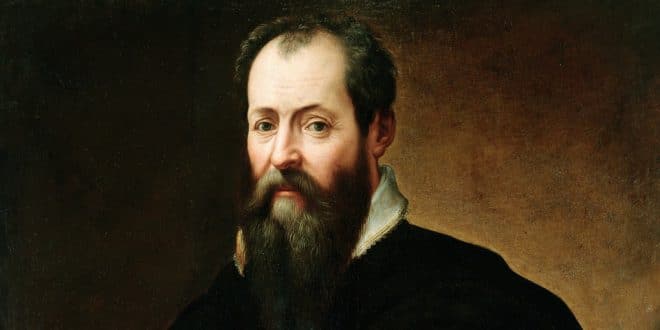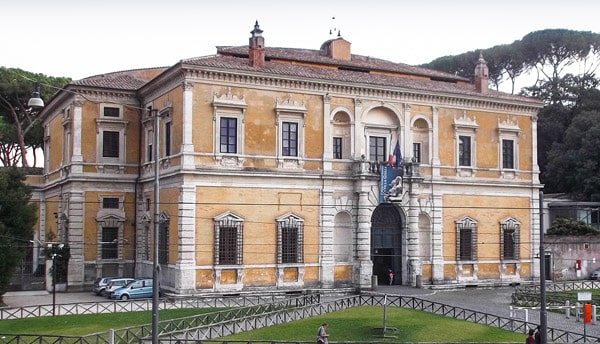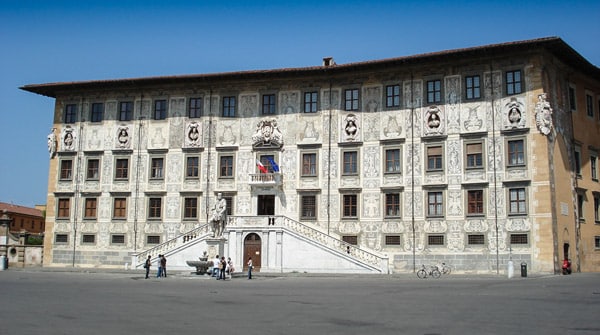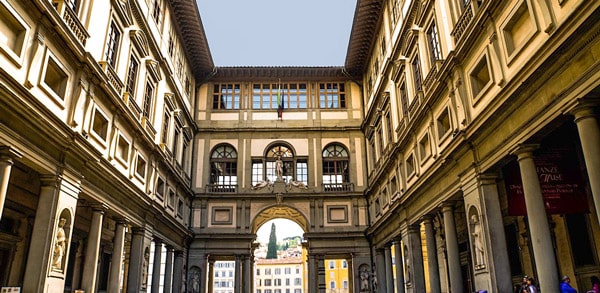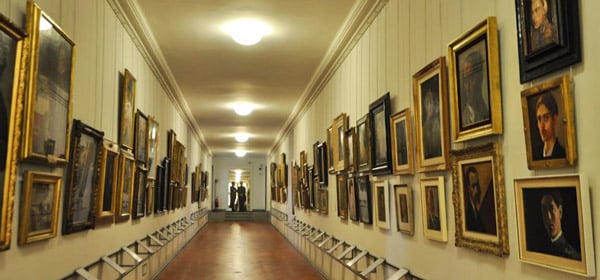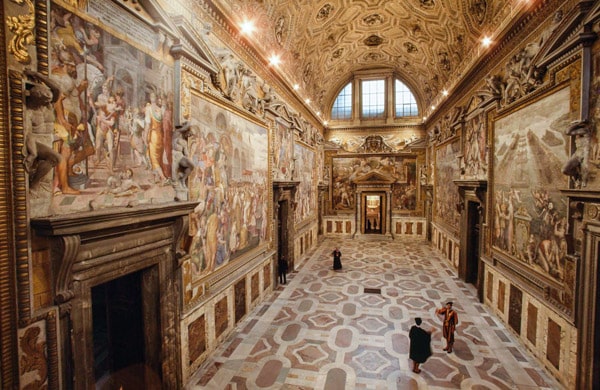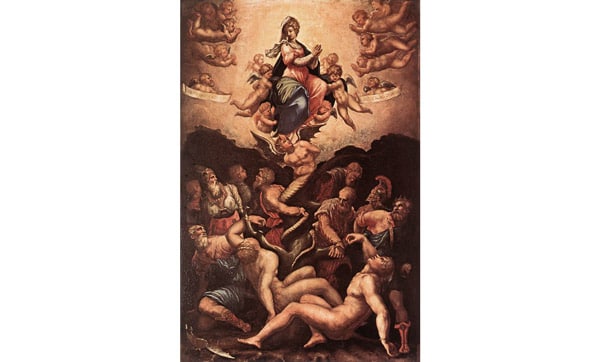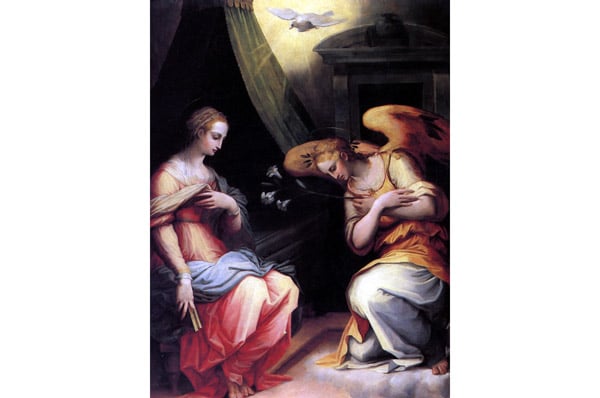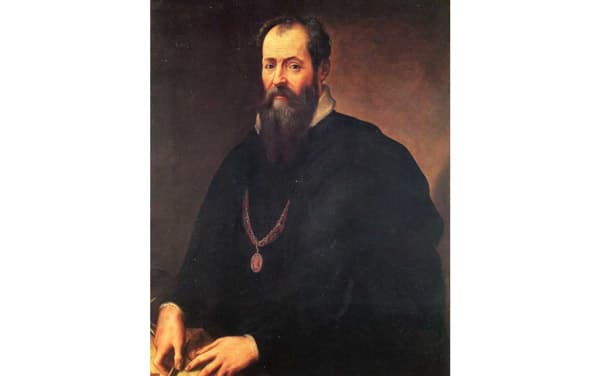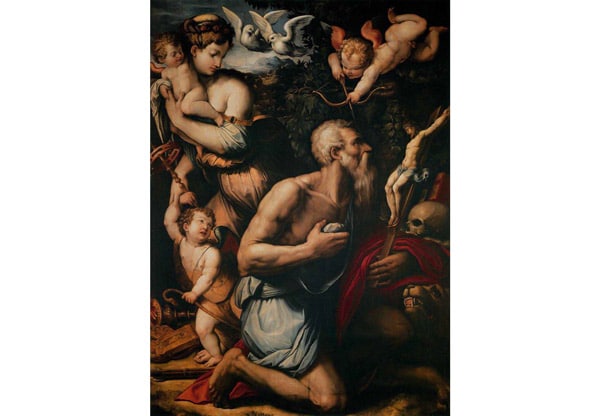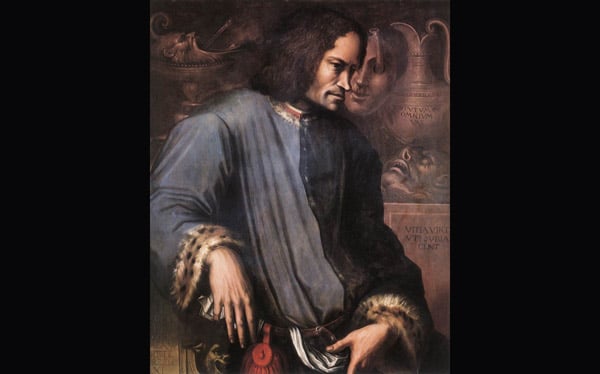Giorgio Vasari, a renowned artist, architect, and writer of the Renaissance era, made a significant contribution to Italian and world art. He was a remarkable individual gifted with various talents and great industriousness.
Thanks to his literary works, interesting biographical facts about the life and creative path of many distinguished contemporaries of the master have become known to future generations.
Page Contents
Biography of Giorgio Vasari
Giorgio Vasari was born in 1511 in Arezzo, one of the oldest cities in Tuscany. He came from a large family of a humble craftsman involved in pottery. Even at an early age, he showed a penchant for creativity and, at the age of 12, began studying decorative arts under the guidance of the French artist Guillaume de Marcillat, who had come to Arezzo to paint frescoes and stained glass windows for the cathedral.
In 1524, Vasari found himself in Florence, where he met his future teacher, the painter Andrea del Sarto. There, he also encountered Michelangelo, who would become not only his mentor but also a friend. While in the capital of the Florentine Republic, the young artist gained the patronage of influential members of the Medici family. However, due to changing political circumstances, Vasari was forced to return to his hometown, where, after the death of his father, he had to support his siblings.
Vasari possessed exceptional diligence, and he traveled extensively, moving from one city to another in search of work. At the same time, he had a knack for winning over influential individuals and gaining their favor, which greatly contributed to his professional growth. Soon, the young artist and architect gained great popularity among his contemporaries and began receiving numerous invitations. He lived and constantly created in Pisa, Rome, Florence, and Bologna.
Giorgio Vasari managed to accumulate wealth, achieve a high social status, and earn the respect of his compatriots, eventually receiving the title of a knight. He made significant contributions to the field of art education: as an experienced master, he engaged in teaching for many years. In 1561, with the financial support of the Grand Duke of Tuscany, Cosimo I de’ Medici, he became one of the founders of the Florentine Academy of Fine Arts (Accademia di belle arti di Firenze).
I recommend reading the book “The Collector of Lives: Giorgio Vasari and the Invention of Art” by Noah Charney and Ingrid Rowland.
Architect
Not all of Vasari’s architectural creations can be considered successful. In particular, the master didn’t always manage to maintain unity of style and form in his work on monumental structures. However, his talent and unique touch were evident in the decoration of buildings.
Several architectural works executed according to Vasari’s designs have been preserved, distinguished by their exceptional beauty and originality. Among the most significant are:
Villa Giulia
Villa Giulia is an architectural complex erected in Rome for Pope Julius III. Construction began in 1550 and was completed five years later.
The grand project carried out in collaboration with renowned masters such as Giacomo da Vignola, Bartolomeo Ammannati, and Michelangelo, represented a magnificent palace consisting of three ensembles.
Unfortunately, not all of the structures have survived in their original state. Since 1889, the villa has housed the National Etruscan Museum (Museo Nazionale Etrusco di Villa Giulia).
Piazza dei Cavalieri
Piazza dei Cavalieri in Pisa, along with the Palace of the Knights of St. Stephen, was reconstructed from a complex of several buildings. The work was commissioned by the Duke of Tuscany, Cosimo I de’ Medici, in 1558.
The façade is adorned with traditional medieval graffito technique featuring intricate relief patterns, allegorical figures, zodiac signs, inscriptions, and later added marble busts of notable citizens and family coats of arms. The palace is named Palazzo della Carovana and currently houses the academic and administrative facilities of the Italian State Center for Higher Education and Research (Scuola Normale Superiore).
Uffizi Gallery
The Uffizi Gallery (Palazzo degli Uffizi) in Florence, the construction of which began in 1560 and was completed 20 years later, after Vasari’s death.
Originally, the building was intended to serve as the main administrative center, housing the city’s main governing bodies, the chancellery, archives, and library. The initial design proposed by the architect underwent significant changes. As a result, the palace acquired the appearance of a structure consisting of two wings connected by a large arcade.
Shortly after its completion, starting in 1581, the Uffizi building housed an art exhibition with unique exhibits, and the collection continued to grow. For several centuries now, this historic museum has remained the most popular tourist attraction not only in Florence but also in all of Europe.
Among the main features of Vasari’s architectural works are his adherence to strict academic canons and classical traditions.
Vasari’s Corridor in Florence
One of the most famous and unusual architectural creations of the master is the covered gallery that connects the Palazzo Vecchio and the Palazzo Pitti, located on opposite banks of the Arno River.
The Vasari Corridor (Corridoio Vasariano), as the 750-meter-long structure is called, was built in record time (5 months) in 1565. The project was commissioned by Cosimo I and was linked to the ceremonial conclusion of a dynastic marriage between the son of the Grand Duke of Tuscany, Francesco I de Medici, and a representative of the ancient Habsburg royal family, Giovanna d’Austria, the youngest daughter of Emperor Ferdinand I.
The influential Medici clan moved to the more spacious Palazzo Pitti in 1560, located on the western bank of the Arno River. The construction of the corridor, connecting the new residence with the Old Palace (Palazzo Vecchio), where the Florentine government held its meetings, allowed titled individuals to quickly and, most importantly, incognito, move from one building to another without leaving the city.
The space of the covered passage was conventionally divided into several sections. It was accessible from both the Uffizi Gallery and through the private apartments of Duchess Eleonora di Toledo. The corridor began with a huge hall known as the “Salone dei Cinquecento” (Hall of the Five Hundred).
This spacious hall was built during the reign of Girolamo Savonarola and could accommodate five hundred representatives of the Florentine people, symbolizing democratic power. During Cosimo I’s time, the hall was used for grand receptions and balls. The walls and ceilings, which were significantly expanded by the architect, were adorned with panels and frescoes depicting the life of the Medici family, executed by Vasari.
A particularly interesting section of the passage features round windows with metal grilles, extending along the waterfront towards the ancient Ponte Vecchio bridge.
Despite numerous restoration works, this stretch of the corridor has been preserved almost intact.
In the exhibition, one can also find a painting depicting Giorgio Vasari, created by the master himself. Access to this section of the corridor is only possible through special guided tour programs by prior reservation.
The section of the gallery that passes through residential buildings and shops on the bridge is equipped with panoramic windows overlooking Florence and the Arno River. In 1939, under the order of Italian dictator Benito Mussolini, the viewing openings were enlarged. Interestingly, during Cosimo I’s time, the meat and fish stalls on Ponte Vecchio were replaced with jewelry shops to prevent the foul smell from disturbing the grand nobility. The pavilions selling gold jewelry and precious stones still operate here today.
In the gallery, there is a section that is adjacent to the ancient church of Santa Felicita. For the Grand Duke of Tuscany and members of his family, a window was carved out of the church wall, and an improvised balcony was constructed. From this balcony, they could attend religious services unnoticed by the congregation.
The final section of the covered passage houses an exhibition of self-portraits by contemporary artists. Extensive restoration work was carried out here in 2013. The gallery concludes with an exit into the courtyard of the Palazzo Pitti and the sprawling Boboli Gardens, which represent a unique park ensemble with grottoes, whimsical statues, and fountains.
Nowadays, the Vasari Corridor is part of the Uffizi Museum complex and is considered one of the most interesting attractions in Florence.
Painter Giorgio Vasari
Giorgio Vasari regarded painting as his calling and distinguished it from all other forms of art. The cycle of frescoes created in the Palazzo Vecchio in Florence and the mural painting in the Sala Regia in the Vatican, depicting scenes from the life of Pope Paul III, eloquently speak of his talent as an artist.
The master’s works were highly sought after, and his paintings enjoyed incredible popularity among his contemporaries. However, in subsequent eras, they faced criticism and, according to some modern experts, did not stand the test of time. The artist was an adherent of Mannerism, characterized by:
- Excessive spirituality;
- Broken lines in the drawing;
- Composition overload;
- Elaborateness and artificiality of the subject matter;
- Distorted depiction of figures;
- Use of vivid effects (playing with sizes, lighting, and perspective);
- Employment of a harsh color palette.
Vasari painted his works very quickly, which was attributed to his hardworking nature as a painter and his utilization of the services of lesser-known young artists when creating large-scale canvases.
Allegory of the Immaculate Conception
The Allegory of the Immaculate Conception is a magnificent artwork dating back to the early period of Vasari’s career, created in 1541.
The technique used is tempera, a special type of painting on a primed wooden panel. The allegorical image of the Madonna, immaculate from birth and trampling the snake (symbol of temptations and seductions), is known from the texts of the Apocalypse. The Virgin Mary rises above the distorted figures suffering below, representing the embodiment of the first sin’s victims. The painting is located in the Florentine church of Santi Apostoli.
Annunciation
Art historians consider the painting “Annunciation” to have been created between 1564 and 1567.
This large-scale work (216×166 cm), executed in oil on wood, was the first commission by Cardinal Ippolito de’ Medici. The basis of the plot is a canonical biblical motif that many Renaissance artists turned to: the archangel Gabriel appearing before the Virgin Mary with the good news of her immaculate conception. The contrast of colors, intricate poses, and abundance of complex symbols—all these characteristics are typical of Vasari’s art. Notably, the painting features a typical backdrop of the artist’s contemporary era against which biblical events of ancient times are depicted. The painting is part of the artistic collection of the Louvre Museum in Paris.
Self-Portrait of Giorgio Vasari
Vasari’s self-portrait, painted in oil on canvas, dates back approximately to the 1560s.
The exact date of the painting’s creation is unknown. The artist disregarded expressive elements such as background or brightly draped clothing. The attention is drawn to two bright spots: the face of a person wise from life’s experiences with a profound, penetrating gaze, and his hands holding a pen and manuscript drafts. In this simple and accessible manner, Vasari succinctly and plainly portrayed himself through the brush and paints.
The Temptation of Saint Jerome
The painting “The Temptation of Saint Jerome” was created in 1541.
This remarkable work, executed in oil on wood, is part of the collection of the Palatine Gallery, located on the upper floor of the Palazzo Pitti. Saint Jerome is revered by Catholics as a Church teacher and the creator of the canonical Latin text of the Bible, which is why he is often depicted with a pen and scroll. Vasari chose a slightly different subject filled with eclectic elements: the righteous Christian man is portrayed struggling with the temptations of the flesh, symbolized by Venus—the ancient Greek goddess of love.
Perseus and Andromeda
The painting “Perseus and Andromeda” was created by the artist around 1570-1572.
On canvas, the artwork depicts a favorite subject from classical mythology, beloved by many Renaissance masters: the valiant Perseus rescuing the young Andromeda, the daughter of the Ethiopian king, who was sacrificed to a fearsome monster. Vasari’s work is infused with eroticism, and at the same time, the abundance of secondary characters, symbols, and the riot of bright colors and contrasts create a sense of chaos and some perplexity. The masterpiece is housed in the museum complex of the Palazzo Pitti.
Portrait of Lorenzo di Piero de’ Medici (the Magnificent)
The portrait of the renowned ruler of Florence was painted posthumously, commissioned by his grandson, Alessandro di Lorenzo de’ Medici, in the 1530s.
The young artist depicted Lorenzo as a tired, emaciated man, gazing sadly into the distance. The painting is imbued with a quiet melancholy, and the image of a powerful and influential person is devoid of any pomp or importance. Only one detail hints at wealth and fame—the red purse that stands out as a bright spot amidst the overall monotony of the color scheme. The famous portrait is located in the Uffizi Gallery.
Read more about Lorenzo the Magnificent.
Lives of the Most Excellent Painters, Sculptors, and Architects
Despite his extensive architectural works and prolific output in painting, Giorgio Vasari immortalized his name by becoming the founder of a discipline known as art history. His fundamental work, “Lives of the Most Excellent Painters, Sculptors, and Architects” (“Le Vite de’piu eccelenti Pittori, Scultori e Architetti”), became the primary source of knowledge for future generations about 178 great Italian artists of the Renaissance era.
Vasari was the first to provide a critical analysis of the artistic works of masters and systematize the theoretical foundation of art history. He introduced the concept of “Renaissance” and categorized it into “Early Renaissance” (14th century), “High Renaissance” (15th century), and “Late Renaissance” (16th century). A colossal and meticulous work was carried out to collect and process materials, including autobiographies, letters, reviews, and memoirs of contemporaries.
All biographies of artists, sculptors, and architects are presented in chronological order. The gallery of historical portraits spans from the mid-13th century to the mid-16th century. Some chapters are supplemented with engravings, including those done by Vasari himself. The information is presented in the form of entertaining novellas, narrating interesting and curious biographical details of the artists, their characteristics, habits, friends, and enemies. Following the descriptions of their life circumstances, there is a comprehensive list of their works along with a detailed art analysis. Vasari provides a thorough assessment of their execution style, manner, technical techniques, and peculiarities. The literary work also presents the history of the author’s life and describes his own creations.
Vasari began creating his monumental literary work around 1540-1546. According to researchers, the impetus for this was his meeting with the historian and humanist scholar Paolo Giovio, who was engaged in biographies of famous people. In 1550, the book was published and achieved enormous success among contemporaries.
Eighteen years later, the second revised version of the five-volume work was published, supplemented with theoretical treatises and portraits. Significant amendments regarding the narrative style were made at the request of the author, first by the writer Annibale Caro and then by the monk Matteo Faetani, both knowledgeable in literature.
Interesting Facts about Giorgio Vasari
- Giorgio Vasari, born on July 30, 1511, in Arezzo, Italy, was not only a renowned painter but also an influential art historian and architect of the Renaissance era. His most famous work is “The Lives of the Most Excellent Painters, Sculptors, and Architects,” a seminal text documenting the biographies of prominent artists.
- Vasari was a close associate of the powerful Medici family in Florence, serving as court painter and architect. He worked extensively on the decoration of the Palazzo Vecchio, creating stunning frescoes such as “The Battle of Marciano” in the Salone dei Cinquecento.
- In addition to his artistic pursuits, Vasari played a pivotal role in the preservation and restoration of famous artworks. He was responsible for the restoration of Michelangelo’s frescoes in the Sistine Chapel, ensuring their long-lasting legacy.
- Vasari’s architectural contributions include the design of the Uffizi Gallery in Florence, an iconic structure that houses one of the world’s most significant art collections. The building’s innovative concept of an arcaded courtyard became an architectural inspiration for future generations.
- Vasari’s artistic style evolved from the early influence of Leonardo da Vinci and Michelangelo to a more Mannerist approach characterized by elongated figures, vibrant colors, and dramatic compositions. His works showcase a mastery of techniques and a deep understanding of human anatomy.
- As an art historian, Vasari pioneered the concept of artistic progress, emphasizing the importance of studying the works of past masters to inspire and inform contemporary artists. His writings significantly shaped the development of art theory and criticism.
- Vasari’s dedication to his craft and passion for art led him to establish the Accademia del Disegno in Florence in 1563, one of the earliest art academies in Europe. This institution aimed to promote artistic excellence and foster collaboration among artists.
 Italy for me From Italy with love
Italy for me From Italy with love

